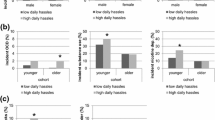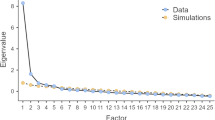Abstract
The development and validation of a new decontaminated hassles measure, the Inventory of College Students' Recent Life Experiences, are described. An initial pool of 85 items was administered to 100 undergraduates along with the Perceived Stress Scale. Forty-nine items were selected based on significant correlations against the Perceived Stress Scale. The alpha reliability of the resultant final form of the Inventory of College Students' Recent Life Experiences and its correlation against the Perceived Stress Scale were both high. In a separate cross-replication sample of 108 undergraduates, the alpha reliability of the Inventory and its correlation against the Perceived Stress Scale showed little shrinkage. Furthermore, separate analyses for male and female subjects supported the reliability and validity of the Inventory of College Students' Recent Life Experiences across gender. Factor analysis of the Inventory yielded seven interpretable factors. Intercorrelations among subscales based on these factors were generally modest, though in all cases significant, suggesting that the Inventory is relatively free of contamination by psychological distress.
Similar content being viewed by others
References
Burks, N., and Martin, B. (1983). Everyday problems and life-change events: Ongoing versus acute sources of stress.J. Hum. Stress 11: 27–35.
Cohen, S., Kamarack, T., and Mermelstein, R. (1983). A global measure of perceived stress.J. Health Soc. Behav. 24: 385–396.
Craik, K. H. (1986). Personality research methods: An historical perspective.J. Personal. 54: 18–51.
De Longis, A., Coyne, J. C., Dakof, G., Folkman, S., and Lazarus, R. S. (1982). Relationship of daily hassles, uplifts and major life events to health status.Health Psychol. 1: 119–136.
Dohrenwend, B. P., and Shrout, P. E. (1985). “Hassles” in the conceptualization and measurement of life-stress variables.Am. Psychol. 40: 780–785.
Dohrenwend, B. S., Dohrenwend, B. P., Dodson, M., and Shrout, P. E. (1984). Symptoms, hassles, social supports and life events: Problem of confounded measures.J. Abnorm. Psychol. 93: 222–230.
Eckenrode, J. (1984). Impact of chronic and acute stressors on daily reports of mood.J. Personal. Soc. Psychol. 46: 907–918.
Endler, N. S., and Parker, J. D. A. (1990). Personality research: Theories, issues and methods. In Hersen, M., Kazdin, A. E., and Bellack, S. (eds.),The Clinical Psychology Handbook, Pergamon, New York (in press).
Feinson, M. C. (1987). Mental health and aging: Are there gender differences?Gerontologist 27: 703–711.
Flannery, R. B. (1986). Negative affectivity, daily hassles, and somatic illness: Preliminary inquiry concerning hassles measurement.Educ. Psychol. Measure. 46: 1001–1004.
Folkman, S. (1984). Personal control, stress, and coping processes: A theoretical analysis.J. Personal. Soc. Psychol. 46: 839–852.
Green, B. L. (1986). On the confounding of “hassles” stress and outcome.Am. Psychol. 41: 714–715.
Jick, T. D., and Mitz, L. F. (1985). Sex differences in work stress.Acad. Manage. Rev. 10: 408–420.
Kanner, A. D., Coyne, J. C., Schaefer, C., and Lazarus, R. S. (1981). Comparison of two modes of stress measurement: Daily hassles and uplifts versus major life events.J. Behav. Med. 4: 1–39.
Krantz, D. S., Glass, D. C., and Snyder, M. L. (1974). Helplessness, stress level, and coronary-prone behavior pattern.J. Exp. Soc. Psychol. 10: 284–300.
Lazarus, R. S., De Longis, A., Folkman, S., and Green, R. (1985). Stress and adaptational outcomes: The problem of confounded measures.Am. Psychol. 40: 770–779.
Lazarus, R. S., and Folkman, S. (1987). Transactional theory and research on emotions and coping.Eur. J. Personal. 1: 141–169.
Lloyd, C., and Gartrell, N. K. (1983). A further assessment of medical school stress.J. Med. Educ. 58: 964–967.
Marziali, E. A., and Pilkonis, P. A. (1986). The measurment of subjective response to stressful life events.J. Hum. Stress 12: 5–12.
Monroe, S. M. (1983). Major and minor life events as predictors of psychological distress: Further issues and findings.J. Behav. Med. 6: 189–205.
Reich, W. P., Parrella, D. P., and Filstead, W. J. (1988). Unconfounding the Hassles Scale: External sources versus internal responses to stress.J. Behav. Med. 11: 239–249.
Russo, J., Miller, D., and Vitaliano, P. P. (1985). The relationship of gender to perceived stress and distress in medical school.J. Psychosom. Obstet. Gynecol. 4: 117–124.
Sarason, I. G., Johnson, J. H., and Siegel, J. M. (1978). Assessing the impact of life changes: Development of the Life Experiences Survey.J. Consult. Clin. Psychol. 46: 932–946.
Siddique, C. M., and D'Arcy, C. (1984). Adolescence, stress, and psychological well-being.J. Youth Adolesc. 13: 459–473.
Thoits, P. A. (1986). Multiple identities: Examining gender and marital status differences in distress.Am. Social. Rev. 51: 259–272.
Thoits, P. A. (1987). Gender and marital status differences in control and distress: Common stress versus unique stress explanations.J. Health Soc. Behav. 28: 7–22.
Tolan, P., Miller, L., and Thomas, P. (1988). Perception and experience of types of social stress and self-image among adolescents.J. Youth Adolesc. 17: 147–163.
Weinberger, M., Hiner, E. L., and Tierney, W. M. (1987). In support of hassles as a measure of stress in predicting health outcomes.J. Behav. Med. 10: 19–31.
Wolf, T. M., Kissling, G. E., and Burgess, L. A. (1987). Hassles and uplifts during the freshman year of medical school.Psychol. Rep. 60: 85–86.
Author information
Authors and Affiliations
Additional information
The work reported was facilitated by a grant from the Social Sciences and Humanities Research Council of Canada's Small Grant Program, administered by the Office of Research Administration, York University. The authors gratefully acknowledge the helpful comments of Dr. Norman S. Endler.
Rights and permissions
About this article
Cite this article
Kohn, P.M., Lafreniere, K. & Gurevich, M. The Inventory of College Students' Recent Life Experiences: A decontaminated hassles scale for a special population. J Behav Med 13, 619–630 (1990). https://doi.org/10.1007/BF00844738
Accepted:
Issue Date:
DOI: https://doi.org/10.1007/BF00844738




